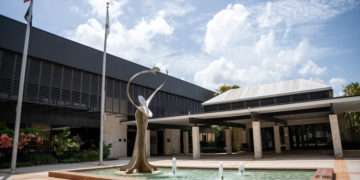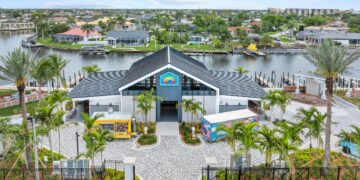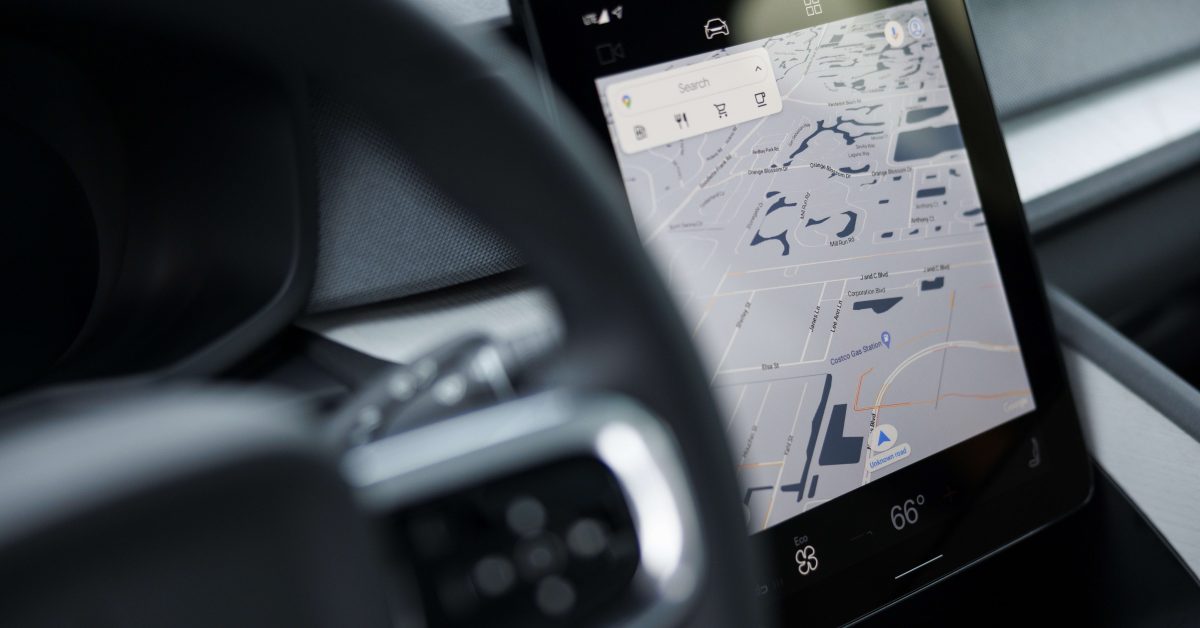Around here, the electric vehicle revolution so far has sounded like the cars themselves. It has been a quiet one in Southwest Florida, where sales of new electric vehicles, or EVs, exponentially have grown over the past five years, but have sputtered behind the rest of the country. In 2023 and beyond, however, the sales of EVs appear poised to accelerate quickly around the region … as soon as supply-chain issues get resolved.
The times, and the energy sources for driving, are changing. Sometimes at a rate that seems as fast as a Tesla Model 3, which can accelerate from zero to 60 mph in 3.1 seconds and reach top speeds of 162 mph. At other times, the pace of change seems as slow as a horse-drawn carriage.
There were 67,952 new cars sold in Southwest Florida in 2022. Of those, 3,649 were EVs, according to sales data from Experian Automotive AutoCount. That means 5.3% of all new vehicles sold in Charlotte, Collier and Lee counties were electric last year. The United States, as a whole, averaged more, with 5.8% of all new vehicles sold, an increase from the 3.2% mark in 2021, according to data pulled by the Wall Street Journal. The same story put the rest of the world at about a 10% market share rate for new EVs against their gas-powered counterparts.
“Now is an historic and exciting time for car makers,” says Joe Parisi, general manager of Polestar in Naples, which has been a part of the Naples Volvo dealership off Naples Boulevard. But Parisi is planning a new standalone showroom, slated to open this year at the Mercato shopping center in north Naples. “It’s an opportunity to seize the moment, do better and dare to build the dream of climate-neutral, beautiful cars. We want to make the car industry a driving force in the shift to a green economy, accelerating the shift to sustainable mobility.”
The local data doesn’t sound like much until comparing it to five years ago. In 2018, there were 66,197 new cars sold across the region. Of those, only 74 were EVs, less than 1% at 0.111%. While the numbers are still a mere fraction of the overall total, the growth rate over the past five years has been 4,674%.
Sales of EVs in Southwest Florida almost doubled from 2019 to 2020, increasing from 76 to 142—a climb that has everything to do with Tesla opening a Fort Myers dealership and showroom in 2020. Tesla opened its Naples showroom at the Waterside Shops off U.S. 41 in December 2016, and has plans to build a 44,800-square-foot service center near Alico Road at what had been a medical mask factory.
The Tesla brand encompassed 78% of all EV sales in 2021 in Southwest Florida (1,572 of 2,014 vehicles). But even as it sold in larger numbers, its market share dropped to 68% last year (2,503 of 3,649 vehicles) as other brands began rolling out their competition.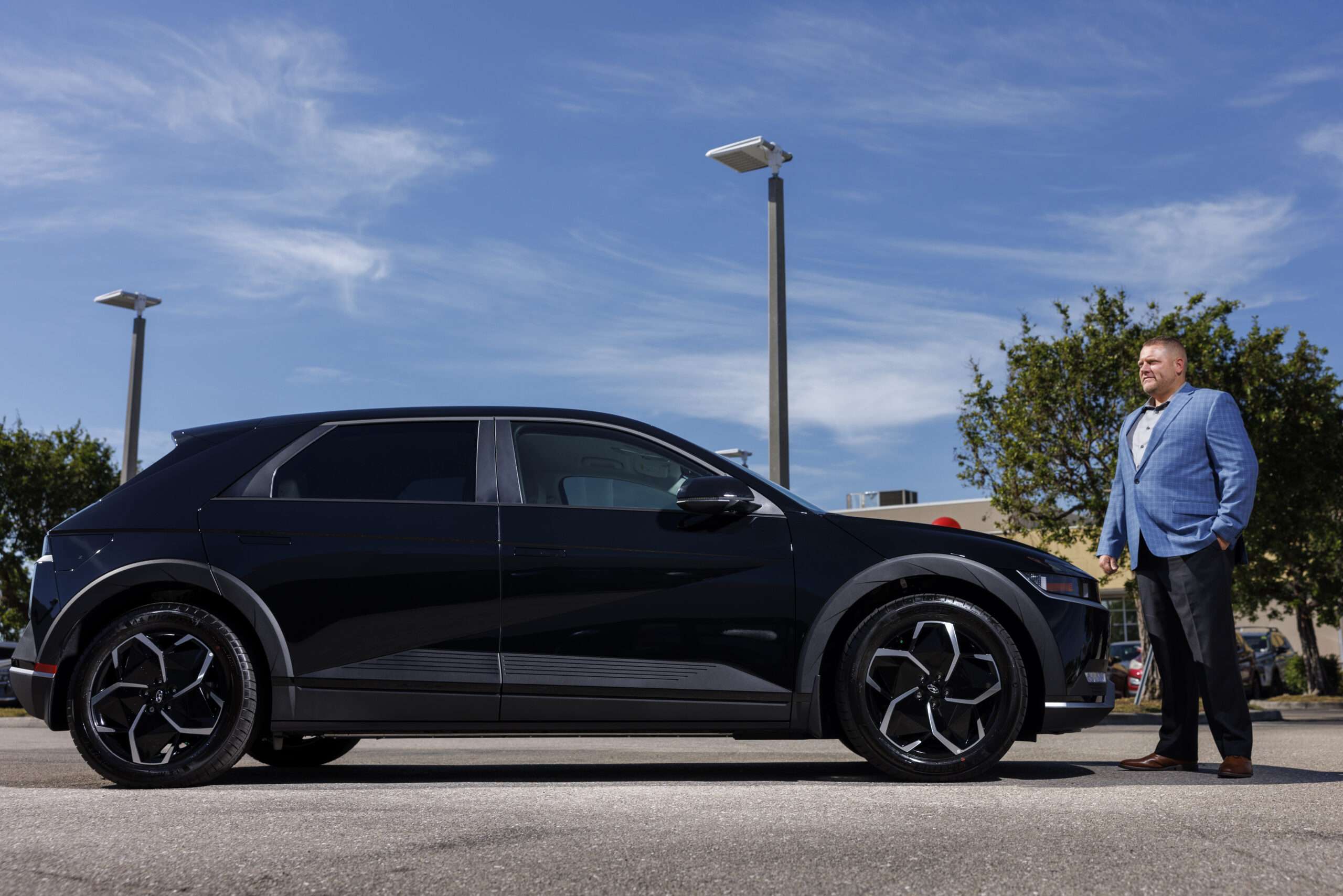
Rise of the new models
In 2018, there were eight models of new EVs sold in Southwest Florida, combining for 74 vehicles. In 2022, there were 18 models, combining for 3,649 vehicles.
Although the traditional, gas-powered automakers are all making EVs now and planning more models for the future, the current ones are tough to find locally. In recent weeks, Gulfshore Business had trouble finding many new EVs at various area dealerships. There were five Volkswagen ID.4 SUVs, of which 53 were sold across the area last year, in Fort Myers. Three were for sale, and two had arrived pre-sold. Those were listed at $47,975 to $53,293.
There was one electric MINI Cooper S, listed at $37,550, at MINI of Fort Myers. Victory Lane Chevrolet in Fort Myers had two Bolts on hand, listed at $40,695 and getting 115 miles per gallon equivalent. Mazda in Fort Myers had two Solterras, listed at $50,432 and $54,032. Sutherlin Nissan in Fort Myers had two examples on hand of the new Ariya SUV, which costs between $43,190 and $60,190, but both of them had arrived to the lot pre-sold. There were zero Leafs at the same store, and there were only five Leafs sold in all of Southwest Florida last year—not due to lack of demand, but because of lack of availability, said Sutherlin Nissan sales manager Jonathan Garcia.
“There’s a lot of people who came in and asked, and we couldn’t get one for them,” he says. “Even more people called, and more people reached out online. The demand for electric cars has risen.”
Garcia noted how the battery efficiency of the new EVs has risen, as well. “In 2017, the Leaf got up to 107 miles on a charge,” Garcia says. “The Leaf, now, can get up to 212 miles. That’s now, a 2023 model. The Ariya can get up to 289 miles, and the highest level gets 304 miles.
“The EVs have been around awhile, so there has been time to tweak things and perfect things. The Ariya, it’s loaded with everything. Sedans are kind of dying out; the world is geared toward SUVs.”
In keeping with that trend is Hyundai’s Ioniq 5, which costs between $41,450 and $56,500. It’s a different dealership, but the same story as at Sutherlin Nissan.
“Almost every Ioniq that comes off the truck has been pre-sold,” says Rex Moonshower, the general sales manager at the Fort Myers Hyundai dealership. “That’s one of the things the manufacturer has gone to. About 75% of them are already claimed. Right now, I have five available.”
The only reason Hyundai has five, Moonshower said, is because the automaker realized sales were soaring at the dealership after Hurricane Ian wrecked so many cars on Sept. 28.
“If you check all the boxes, you’re rewarded for your hard work,” he says. “We were able to get more inventory. The Ioniq 5 is very retrofitted. It’s also very different from anything else on the market.”
Local companies hesitant to switch
Scotlynn, a Lee County-based national produce and food transportation company, has a fleet of about 430 trucks that are moving about 80,000 pounds each, per day, an average of 400 miles per trip, company president Ryan Carter said. When his company built its new headquarters just north of Alico Road and west of Interstate 75, he had electrical conduit run to some of the parking spots, “because I figure at some point we’ll have electric vehicles.”
That point hasn’t arrived yet.
“We haven’t had anybody ask about one,” Carter says of installing a charging station for employees. “There are some kinks to work out. I’m sure at some point, we’ll take it more seriously.”
What Carter does take seriously is hauling produce at peak efficiency. If a hypothetical electric truck could haul less product because of the size and weight of a battery, it wouldn’t make sense to switch from a gas-powered truck, he said.
“The batteries aren’t there yet for long-haul trucking, which is mostly what we do,” Carter says. “A battery for 400-plus miles, it’s not really feasible. It’s hard to pinpoint when we’ll have that technology. You can always add more batteries, but then you’re adding more weight. That’s counterproductive. I can see it being good for like a 23-foot truck hauling stuff around town. But not doing big-time miles.”
LeeSar and Cooperative Services of Florida distributes medical supplies and pharmaceuticals for Lee Health and three other hospital groups in Florida. The Fort Myers-based company owns a fleet of more than 45 vehicles that are both leased and owned, said Barb Fernandez, LeeSar’s vice president of human resources. None of them are electric.
“The LeeSar tractor-trailers, box trucks, vans and cars travel many miles every day and are on very tight schedules,” Fernandez says. “Charging availability and time-to-charge requirements are two main considerations.
“We will continue to monitor how the EV industry improves for heavy-use, commercial settings and embrace options that are best aligned with our ability to support our health care systems while also being responsible to our communities and our environment.”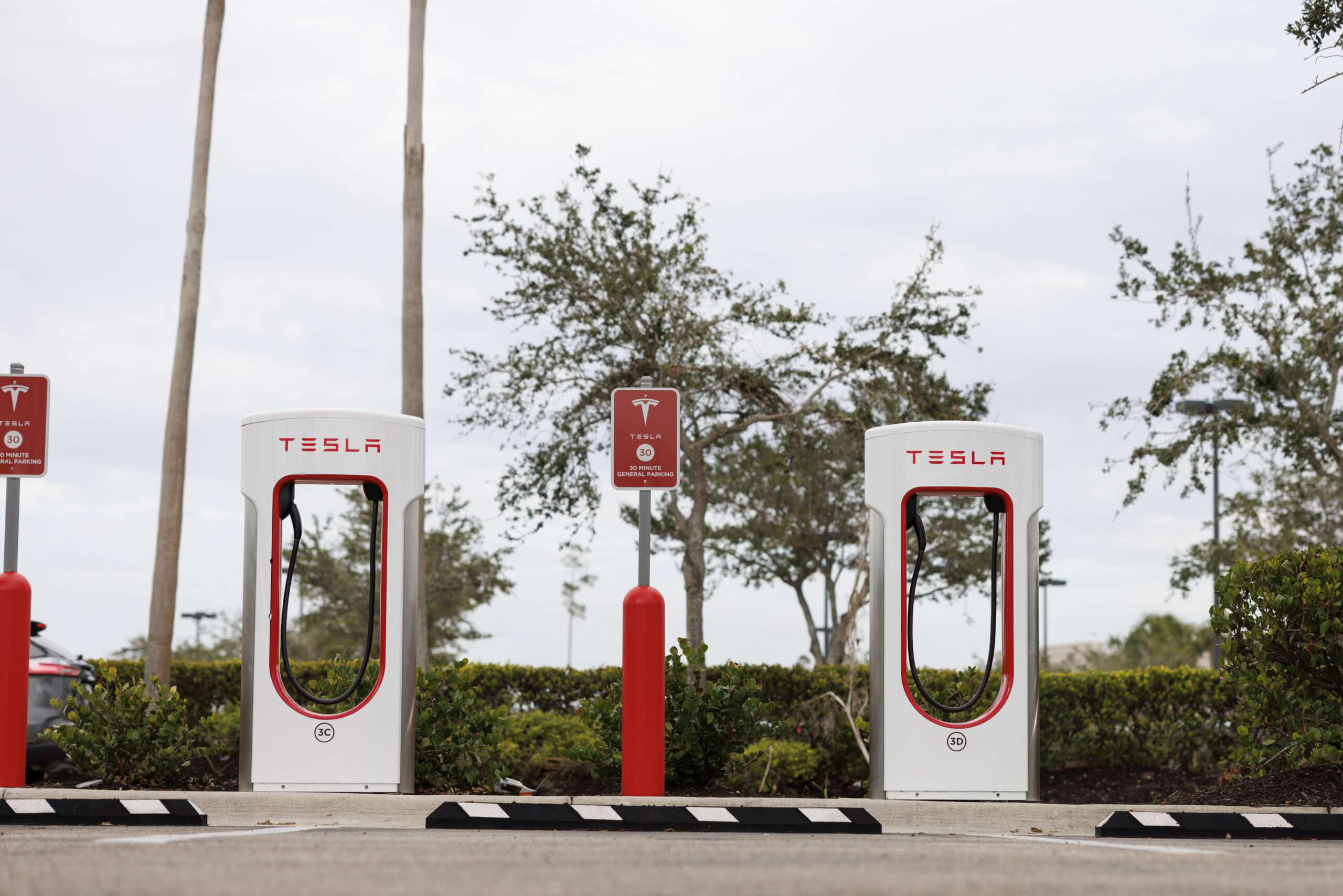
Getting charged
The Hyundai brand offers some perks with a purchase. One of them, Moonshower said, is two years of free charges at any Electrify America charging station.
“There’s a special code that comes with each car,” he says. “It’s attached to the vehicle. We enroll the consumer in it. They can charge it at any charging station.”
But so far, Electrify America has just two charging stations in Southwest Florida, according to its website. One is at Walmart at 9885 Collier Blvd., in Naples, where there are four charging ports; two of the “hyper-fast” variety, and one labeled “ultra-fast.” The other is at Walmart at 375 Kings Highway in Port Charlotte with the same setup as in Naples.
Tesla has fewer than 40 Destination Charging stations spread across the region, from two in Marco Island to 19 in the Naples area, two in Bonita Springs, one in Cape Coral, five in Fort Myers and one each in Sanibel Island, Captiva Island and Punta Gorda.
It seems like not enough, said Michael Boehm, which is why his company makes portable EV charging stations. Juice Americas Inc., headquartered stateside in St. Petersburg, sells portable, 22-kilowatt charging stations. They start at $549 on Amazon, which is where most of them are sold, Boehm said. Someone on a road trip staying at a rental home or at a friend or family member’s house without an EV charging setup can just bring the charging station, which weighs less than eight pounds, with them.
“You can,” Boehm says when asked if travelers can take the “great American road trip” in an electric vehicle. “It’s just a little bit more of an adventure than it is with a gas car. But you can absolutely do it.”
For those who regularly drive less than 200 miles per day, buying an EV is a “no-brainer,” Boehm said. There are other issues drivers in the Sunshine State won’t have to face compared to their northern counterparts, either. “The colder it is, the less range that you have in an electrical car,” Boehm says. “That’s one issue you don’t have in Florida.”
Also of note is how people’s relationships with energy are changing, said Kevin Hernandez, a partner with the Raleigh, North Carolina-based Scott Madden consulting firm, which helps prepare businesses for shifting their energy consumption to solar power and EVs. “It’s gone from flipping on a light switch to much more than that,” Hernandez says. “It used to be, as long as the lights were coming on, people were happy. Now, people look at things a little bit differently. In a lot of ways, people are bringing their energy back home with them.”
That’s in part because of shopping centers such as Miromar Outlets in Estero, which has 32 charging stations, 16 for Tesla-branded vehicles and 16 generic chargers. It’s the largest charging facility in Southwest Florida.
Gearheads vs. torque-heads
Jay Ganzi, managing partner at Cape Coral Chrysler Dodge Jeep Ram dealership off Pine Island Road, didn’t have any pure EVs for sale on his lot, but he did have a handful of Jeep Wrangler 4 x E’s, which are hybrids that get about 49 miles per gallon. They can drive in three modes: gas, electric and hybrid, with electric having a range of about 60 miles—enough for a short commute.
All four of the on-site, new auto brands have pure EVs in the works, and Ganzi expected them to arrive by the end of this year or early 2024.
“I think that true horsepower people will always want high-power cars and the rumble of the V8 engine,” he says. “The gearheads, they like to hear their cars roar.”
Ganzi has been behind the wheel of EVs. He knows they accelerate faster than gas-powered cars and can drive faster than them, too. But do not underestimate gas-powered car enthusiasts, he said. They will keep traditional cars on the road.
“I miss the sound of the motor,” he says. “Maybe I’m old-school. My thoughts are people are still going to want natural horsepower. Muscle-car people and enthusiasts.”
Even so, Ganzi said the EV era is arriving. He expected his dealership to offer a 50/50 split of gas-powered and electric vehicles within about 10 years.
Other industry estimates are more conservative. “The models that we regularly review indicate a 32-to-35% growth rate between now and the 2030 time frame,” Hernandez says. “I would say 2035 would be conservative for it to be 50/50.
“I think the battery technology will continue to evolve. There’s a lot of emphasis to make batteries smaller and more power dense.”
Hernandez also predicted companies such as LeeSar and Scotlynn will be switching to EVs sooner than even they might think.
“There’s a lot of efforts on commercial fleet vehicles,” he says. “Delivery vans and those kinds of things. I wouldn’t be surprised if those go electric even sooner. The reason why is if you’re a company, and you’re operating a fleet of vehicles, there’s a real advantage. They’re cheaper. There’s a lower maintenance cost.”
The “gearheads” could become “torqueheads” when they learn, for example, that the 2024 Polestar 2 will carry up to 455 horsepower and 546 pounds per foot of torque—the measure of force that enhances the car’s ability to turn – on the dual motor variant. The single-motor variant will have up to a 300-mile range. Both will be eligible for the $7,500 U.S. government rebate as part of the Inflation Reduction Act.
Boehm of Juice America said the average gas-powered car lasts 13 years. That means it could be at least about a decade until the tipping point when EVs outnumber gas-powered vehicles.
Studies also have shown that it takes about two years for EVs to offset the burning of carbon required to produce a car battery.
“Gas cars won’t go away as quickly as some people may want them to,” Boehm says. “But electric cars—let’s be honest, we’re a nation of drivers. If you haven’t driven an electric car, an electric motor has the maximum torque. You have instant power with an electric motor. An electric has all the power available from the start. It is extremely nice to drive an electric car. I am sure that a lot of the gearheads, they’ll be adopting electric cars.”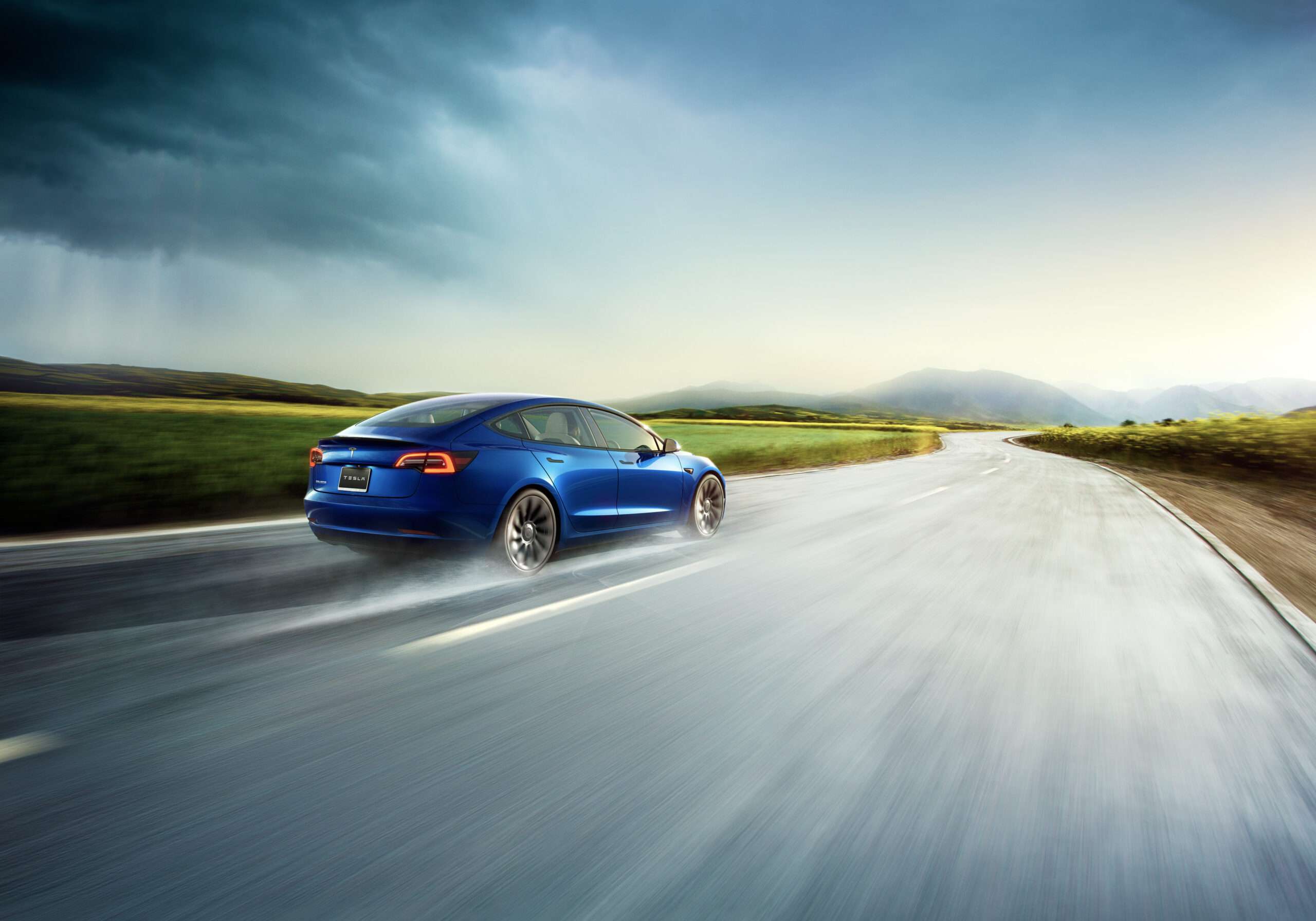
Electric road test
The assignment seemed simple: I would drive an electric vehicle to Orlando for a fun weekend getaway, return in triumph and write about it. But there were challenges. And even though I didn’t run down the battery and get stranded, I still made a bunch of first-time blunders.
My wife, Bonnie, and I left on a Friday morning, bound for the Hard Rock Live that night. I rented a Polestar 2 from Hertz, which has its headquarters in Estero and has committed to adding 175,000 electric vehicles to its fleet over the next five years.
As we left, the dashboard showed the battery at 80% charged with a range of 200 miles. It’s about 190 miles from our house to the Orlando hotel via Interstate 75 and Interstate 4, but just 153 miles by cutting up the center of Florida along State Road 17. So we chose the latter route.
We stopped for lunch at Disney Springs, which has a bank of charging stations. I plugged in, and the yellow light in the car’s charging port glowed yellow, so it must have been charging, right?
Two hours later, we learned it wasn’t. I had neglected to pay.
After 150 miles of driving, the battery had run down to 16% power and showed a range of a mere 40 miles. That covered us for the 11 remaining miles to the hotel, where I dropped off Bonnie to go look for a charging station.
Hertz told me the car’s trunk had a Tesla charging adapter and a regular wall outlet adapter. A nearby Wawa had a bank of Tesla charging stations, where I learned the adapter didn’t work with the Polestar. (Upon returning home, I realized the regular wall outlet adapter wouldn’t charge the car either).
A Google search showed a ChargePoint station less than half a mile from the hotel. I found it and spent almost an hour learning. I downloaded the phone app required to charge, set up the online credit card payment, plugged in and made sure the car’s plug-in light was flashing green this time.
It took overnight, about 13 hours, to reach 100% charge, costing $34.82. After a Saturday trip to Mount Dora, we returned to top it off with energy for the ride back to Fort Myers, paying $6.43 over three hours to add 65 miles more range, giving the battery 89% life and a 230-mile range for the ride home.
After returning to Fort Myers, I found a free charging station to boost the battery from 13% back to 100% and the maximum 260-mile range. Monday morning, I had to return the Polestar 2, paying $201 for three days of rolling in a $48,400, powerful, smooth and quiet-driving machine. I really wish it were mine, despite Florida’s charging infrastructure clearly not being ready for the masses. But when it is, I’ll be waiting.
—David Dorsey
On the level
There are three levels of charging for an EV: Level 1, Level 2 and Level 3.
“Level 1 charging is when you use a regular electrical outlet,” Michael Boehm explains. “That will take you 27 to 30 hours to charge. The next level is Level 2 charging, which also can be done from home. Most of the charging stations you find are Level 2 charges. You can fully recharge your car in about four to six hours. That is the kind of charging you would be using at your home. Or, if you’re at the supermarket, and you want to go shopping at a mall, and you’re going to be there for three hours.
“Then you have Level 3 charging. There, you can recharge a car in about 20 minutes to half an hour. That’s the kind of charging you can find along the interstates. That’s the kind of infrastructure you still need in the United States.”
EVs by the numbers
The percentage of electric vehicles versus gas-powered ones has grown from next to nothing to 5.3% over the past five years in Southwest Florida.
Here’s a breakdown looking at numbers of each model sold from 2018 through 2022.
2022
New cars sold: 67,952
New EVs sold: 3,649
Percentage: 5.3
Models: Tesla Model Y, 1,110; Tesla Model 3, 874; Tesla Model X, 261; Tesla Model S, 258; EV6, 126; Ford Mustang Mach-E, 114; Porsche Taycan, 110; EQ5, 99; Hyundai Ioniq 5, 84; Chevy Bolt EUV, 75; Volkswagen ID.4, 53; Chevy Bolt EV, 31; Audi E-Tron, 29; Audi SS Sportback, 28; Audi Q4 E-Tron, 18; Audi E-Tron Sportback, 14; Nissan Leaf, 5; Toyota Prius Prime, 5
2021
New cars sold: 76,026
New EVs sold: 2,014
Percentage: 2.6
Models: Tesla Model 3, 747; Tesla Model Y, 623; Tesla Model S, 202; Porsche Taycan, 139; Volkswagen ID.4, 101; Chevy Bolt EV, 80; Ford Mustang Mach-E, 74; Toyota Prius Prime, 24; Audi E-Tron Sportback, 12; Chevy Bolt EUV, 7; BMW i3, 3; Audi SS Sportback, 2
2020
New cars sold: 63,354
New EVs sold: 142
Percentage: 0.22
Models: Chevy Bolt EV, 59; Tesla Model S, 27; Porsche Taycan, 26; Tesla Model 3, 10; Toyota Prius Prime, 10; Tesla Model X, 6; Nissan Leaf, 3; BMW i3, 1
2019
New car sold: 64,164
New EVs sold: 76
Percentage: 0.11
Models: Chevy Bolt EV, 21; Honda Clarity, 17; Toyota Prius Prime, 16; Chevy Volt, 10; Nissan Leaf, 9; BMW i3, 3
2018
New cars sold: 66,197
New EVs sold: 74
Percentage: 0.11
Models: Honda Clarity, 19; Nissan Leaf, 18; Chevy Bolt EV, 16; Chevy Volt, 9; Toyota Prius Prime, 5; BMW i3, 5; Tesla Model 3, 1; Tesla Model S, 1

